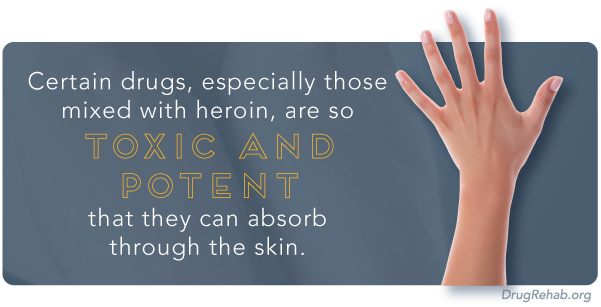
Needle fixation occurs when the act of injecting becomes compulsive, rewarding, and equal to or more important than the actual act of using the drug itself. Certain experts actually consider needle fixation to be a separate addiction, with some referring to it as a behavioral addiction. A needle fixation can increase the already present risks which accompany injection drug use, such as infection, transmissible disease, and death.

Not every individual who injects drugs will develop a needle fixation. But those who do, entertain thoughts and engage in behaviors increasingly shaped by this compulsion. The Public Sphere reports that “Estimates suggest that needle fixation is observed among a quarter of injecting heroin users.” So how does a person develop a needle fixation and what does it entail?
Intravenous (IV) Drug Abuse: The Basics
Injecting drugs is the most invasive, and dangerous, way a drug abuser can administer a drug. To do this, an individual fills a needle or syringe with the desired drug of abuse. Intravenous drug users (IDUs) inject drugs the following ways:
- Intramuscularly: Into the muscle
- Intravenously (IV): Into the vein
- Subcutaneously (“Skin-popping”): Right below the skin
Some of the most addictive drugs known to man are used this way, including heroin, crack cocaine, methamphetamine, and morphine, among others.
What Is A Needle Fixation?
In short, it’s when a person compulsively uses needles. Further, the individual’s fixation on needles either equals or surpasses their desire to use the drug. The act of injecting, in and of itself, provides a sense of reward which is separate from the “rush” or “high” of the drug.
A more technical definition, sourced from a research report published in the journal Addiction, cites that is is “Repetitive puncturing of the skin with or without the injection of psychoactive drugs via intravenous, subcutaneous or intra-muscular routes, irrespective of the drug or drugs injected or the anticipated effects of the drug.”
Considering the fact that addiction, especially an addiction to hard drugs like heroin and crack cocaine, overrides a person’s desire for most anything else, this is pretty extreme. This is why some experts refer to a needle fixation as an addiction itself.

The Public Sphere notes that three themes lead certain people to develop “an addiction to the injecting process,” including:
- Previous obsessive traits
- Irrational superstitions
- Insecure attachments
These individuals harbor perspectives and reactions to needles and needle use which can endanger their health and even those around them.
What Behaviors And Thoughts Are Associated With A Needle Fixation?
Like other harmful behaviors surrounding substance abuse, a needle fixation is steeped in some very unhealthy and negative thoughts and behaviors, such as those outlined by the Addiction report:
- Ritualization: A person becomes obsessed with preparing the needle for injection.
- Relishing the skill of injecting: User’s claim that their skill at injecting increases their self-esteem.
- Substitution of other drugs or water: Some people may fixate on the injection so much that they turn to these substances if their drug isn’t available, just so they can inject.
- Pleasure at injecting: The injection itself creates a sense of well-being and enhances the rush of the drug.
- Pursuit of pain: Certain individuals report liking the pain associated with the injection (masochism).
- Linked to deliberate self-harm: Some individuals inject as a means to purposely harm or punish themselves.
- Association with sex: Injection is linked to sexual pleasure and as a way to create intimacy.
Specifically, a person with a needle fixation may:
- Feel a rush or “buzz” simply by using the needle, even before the drug hits their system.
- Become sexually aroused by injecting, or being injected by, their partner.
- Find that they replace sex in increasing instances with the ritual of injection.
- Believe it would be harder to give up injection than the actual drug of abuse.
- Feel the process of preparing the needle for injection is as, or more, important than the high.
- Feel calm or more relaxed after they inject water.
- Enjoy the pain that results from the injection (either when injecting their self or when injected by others.)
- Become infatuated with the needle because of how they equate it to this pain.
- Pull blood in and out of the syringe prior to or following injection (“flushing”).
These behaviors can put a person in harm’s way. For instance, when a person is injecting a partner, especially if they equate a sexual feeling to the act, they are more apt to share needles. This practice drastically increases the risks associated with injection. As these behaviors accompany drug abuse, comprehensive treatment should be sought which addresses both concerns.
What Are The Dangers Of Injecting Drugs?
A needle fixation can jeopardize an IDU’s health and life. When this desire becomes so strong, coupled with the already overwhelming urge to use, a person may resort to sharing needles, using dirty needles, or using old needles, all of which increase the risk of infection, transmissible disease, and as a secondary effect, death.
- Abscesses
- Addiction
- Cellulitis
- Collapsed veins
- Cotton Fever
- Hepatitis B and C
- HIV/AIDS
- Limb amputation
- Necrotizing fasciitis
- Organ failure
- Sepsis
- Track marks
Many of these conditions can accelerate into critical stages and lead to death.
Recognizing a needle fixation, and educating an IDU on it, is key to preventing these risks and opening the conversation up for treatment.
Why Is It Important To Understand Needle Fixations?
Some findings illustrate that individuals with a needle fixation are more impulsive than their IDU counterparts who don’t have a fixation. Some research even posits that a needle fixation should be classified as a behavioral addiction and treated as such.

In keeping these concerns in mind, treatment should address any issues which relate to impulsive and/or ingrained negative behaviors. Effective treatment should treat both the drug addiction and the dysfunctional thoughts and behaviors linked to the needle fixation.
Does A Needle Fixation Alter A Person’s Treatment Needs?
Yes. A BMJ Journals article explains how a needle fixation can influence treatment:
“When treating injection drug users it is important to simultaneously assess needle fixation because this would influence the treatment outcome…Understanding needle fixation as deliberate self harm can encourage testing pharmacological interventions in addition to behavioral therapies.”
Any time an individual enlists in rehab, to optimize treatment results, the facility’s staff should seek to understand a their unique situation as fully as possible. Understanding a person’s perspectives on drug abuse is important and can help to inform an individualized treatment approach.
How Do You Treat A Needle Fixation?
Many of the same modalities used to treat drug addiction may also benefit a person’s pursuit of overcoming their needle fixation. Behavioral therapies, such as cognitive behavioral therapy (CBT) and dialectical behavior therapy (DBT) can be impactful methods for treating matters of impulse control, self-harm, abnormal sexual proclivities, and dysfunctional behaviors.

On this subject, one paper asserts that “Consequently, current evidence-based treatments for behavioral addictions could be modified to address the inherent difficulties of impulse control in those identified as needle-fixated injecting drug users.”
Therapy and counseling work to restore positive and healthy thoughts, emotions, and behaviors which build up sobriety and undue the damage done from the needle fixation and addiction. Additionally, these behavioral therapies are key components of treatment for any co-occurring mental health disorders, like depression or past trauma.
Begin Building Healthy Behaviors For Sobriety Today
A good treatment program can work to treat needle fixation and as well as addiction. If you’re interested in learning more about how inpatient drug rehab can help you in these ways, let DrugRehab.org help. Your call is one hundred percent confidential. Contact us today.


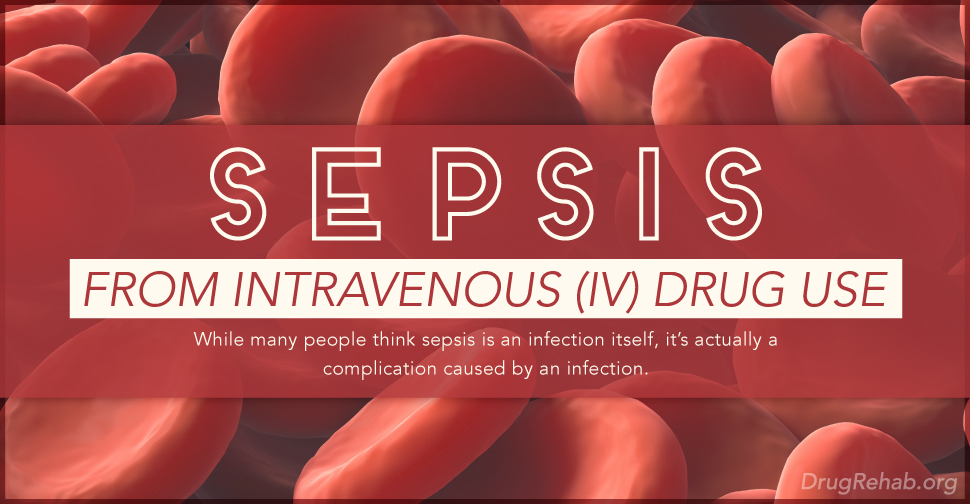
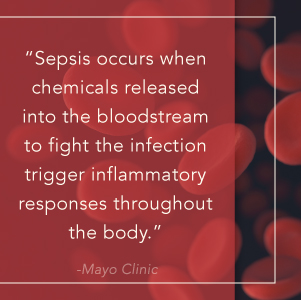

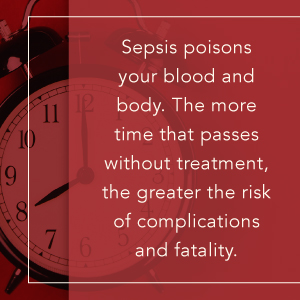
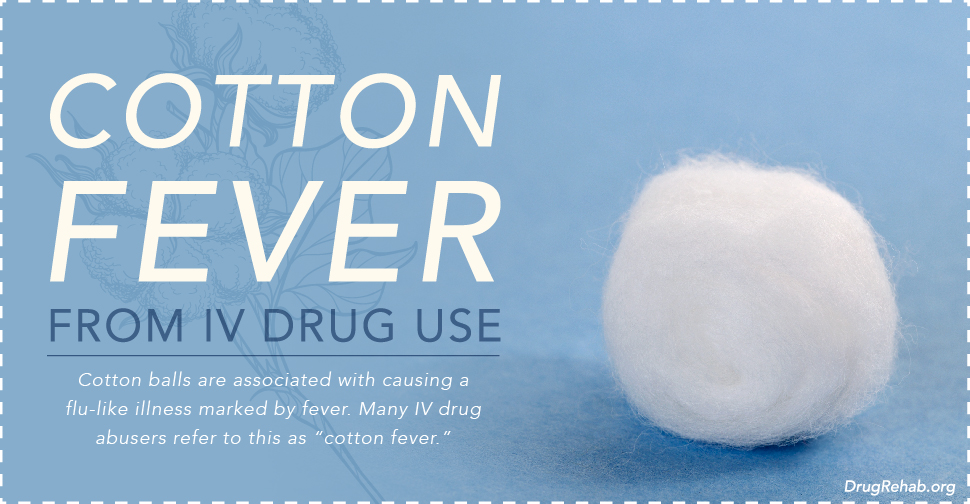
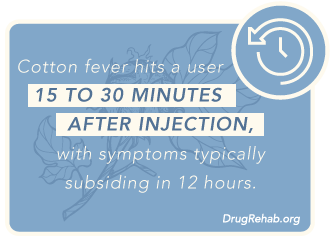 Again, cotton balls are commonly used for this purpose since they are so cheap and readily available. Once a drug is in liquid form, a person draws the substance through the filter and into the syringe. The forearm is a
Again, cotton balls are commonly used for this purpose since they are so cheap and readily available. Once a drug is in liquid form, a person draws the substance through the filter and into the syringe. The forearm is a 
 Immunologic theory: Users have antibodies for the cotton which cause a reaction after injection
Immunologic theory: Users have antibodies for the cotton which cause a reaction after injection
 The most frequently used veins are those in the crook of the forearm, though other locations may be used. If a person injects into their arm, it’s typically the one opposite from the hand they write with. This makes it easier for them to inject the drug themselves. To work around this, some people may have a fellow drug abuser inject the substance for them into their dominant arm.
The most frequently used veins are those in the crook of the forearm, though other locations may be used. If a person injects into their arm, it’s typically the one opposite from the hand they write with. This makes it easier for them to inject the drug themselves. To work around this, some people may have a fellow drug abuser inject the substance for them into their dominant arm.
 Injection drug users face increased risk of blood-borne infectious diseases, such as HIV/AIDS and Hepatitis B and C.
Injection drug users face increased risk of blood-borne infectious diseases, such as HIV/AIDS and Hepatitis B and C.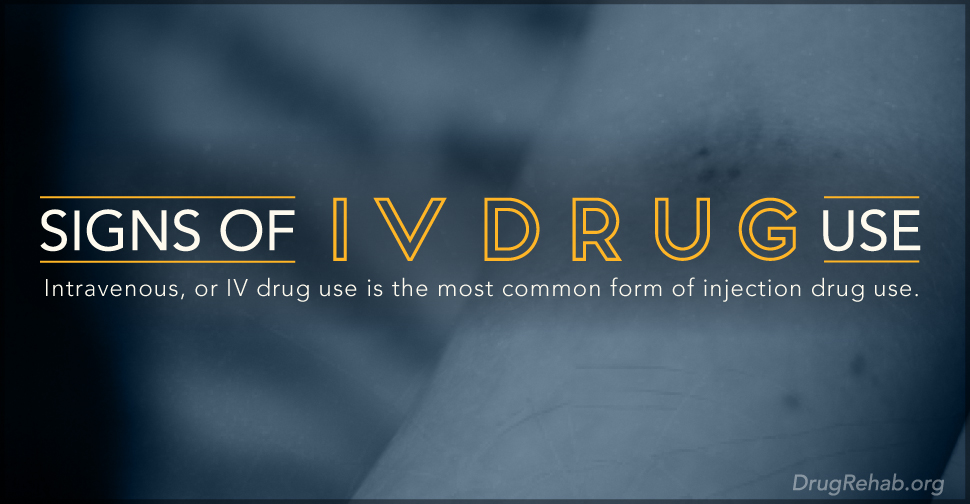

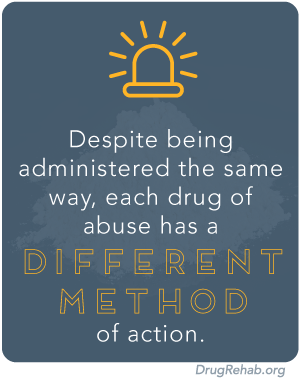 When a drug abuser injects a drug, they need certain equipment. These items are collectively termed paraphernalia. Finding these objects can be a telltale sign that a person is engaging in IV drug use. The most obvious one would be a syringe (insulin syringes are frequently used). You might also find pill bottles, baggies, or balloons which contained the drugs.
When a drug abuser injects a drug, they need certain equipment. These items are collectively termed paraphernalia. Finding these objects can be a telltale sign that a person is engaging in IV drug use. The most obvious one would be a syringe (insulin syringes are frequently used). You might also find pill bottles, baggies, or balloons which contained the drugs.